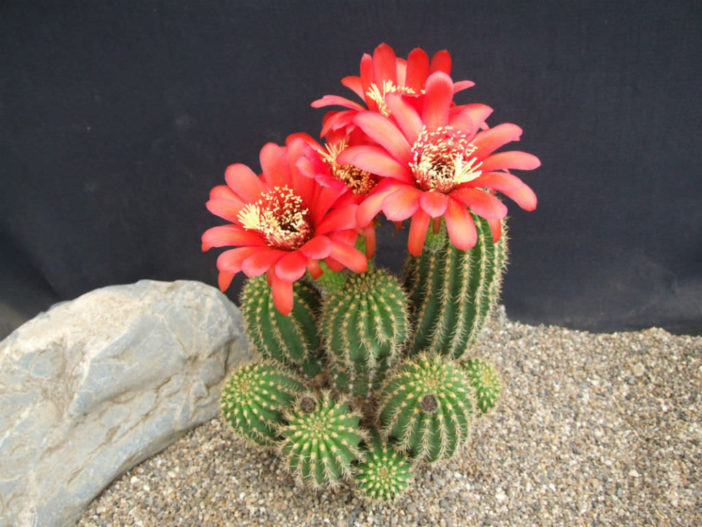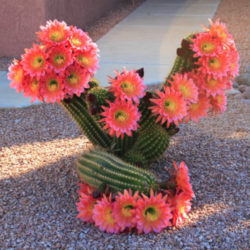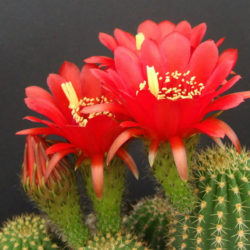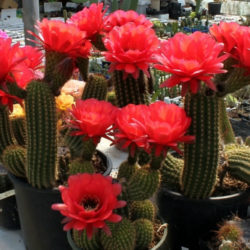Scientific Name
Echinopsis huascha var. grandiflora
Accepted Scientific Name
Echinopsis huascha (Web.) Friedrich & G.D.Rowley
Common Name(s)
Desert's Blooming Jewel, Red Torch, Red Torch Cactus
Synonym(s)
Chamaecereus grandiflorus, Helianthocereus grandiflorus, Lobivia grandiflora, Lobivia huascha var. grandiflora, Trichocereus grandiflorus
Scientific Classification
Family: Cactaceae
Subfamily: Cactoideae
Tribe: Trichocereeae
Genus: Echinopsis
Description
Echinopsis huascha var. grandiflora, formerly known as Lobivia grandiflora or Trichocereus grandiflorus, is a columnar cactus with globose to cylindrical stems with 12 to 18 ribs lined with whitish areoles bearing clusters of reddish spines. It has reddish, much shorter spines than Echinopsis huascha var. huascha and somewhat resembles Echinopsis schickendantzii but mostly has bright red flowers. The stems can grow up to 3 feet (90 cm) tall and 4 inches (10 cm) in diameter, branching from the base to form a dense clump. Each areole bears 1 to 2 central spines, measuring up to 0.4 inches (1 cm) long, and 9 to 11 usually shorter radial spines.
The diurnal flowers are funnel-shaped and appear near the end of the stems, reaching up to 4 inches (10 cm) in length and 2.8 inches (7 cm) in diameter.
Origin
Echinopsis huascha var. grandiflora is not recognized as a separate variety and is treated as a synonym of Echinopsis huascha. It is native to Argentina and grows on steep rocky slopes in Catamarca at elevations that range from 3,280 to 6,890 feet (1,000 to 2,100 m).

Hardiness
USDA hardiness zone 9b to 11b: from 25 °F (−3.9 °C) to 50 °F (+10 °C).
How to Grow and Care
If you can grow cacti and succulents successfully, you can likely grow the Echinopsis species without much trouble. Like many cacti, they prefer a drying period between waterings, even when slightly wilt. When you water, however, you should water deeply. The plant will noticeably plump up. The cactus mustn't be exposed to prolonged dampness and sitting water. Never let your cactus sit in a dish of water. Lastly, ensure fertilizer during the growing season for the best results.
Echinopsis can be easily rooted from offsets, which tend to cluster around the base of the mother plant. Cut offsets close to the stem at the narrowest possible place. When rooting cacti from cuttings, let the fresh cutting dry out slightly on a paper towel and cut the cacti at the narrowest place possible. After a few days to a few weeks, depending on the size of the cut surface, the cut surface should have dried out and formed a callous or slightly rough opening. Once the callous has formed, place the cutting in a rooting mixture of fast-draining cacti soil.
See more at How to Grow and Care for Echinopsis.
Links
- Back to genus Echinopsis
- Succupedia: Browse succulents by Scientific Name, Common Name, Genus, Family, USDA Hardiness Zone, Origin, or cacti by Genus
Photo Gallery
Click on a photo to see a larger version.


